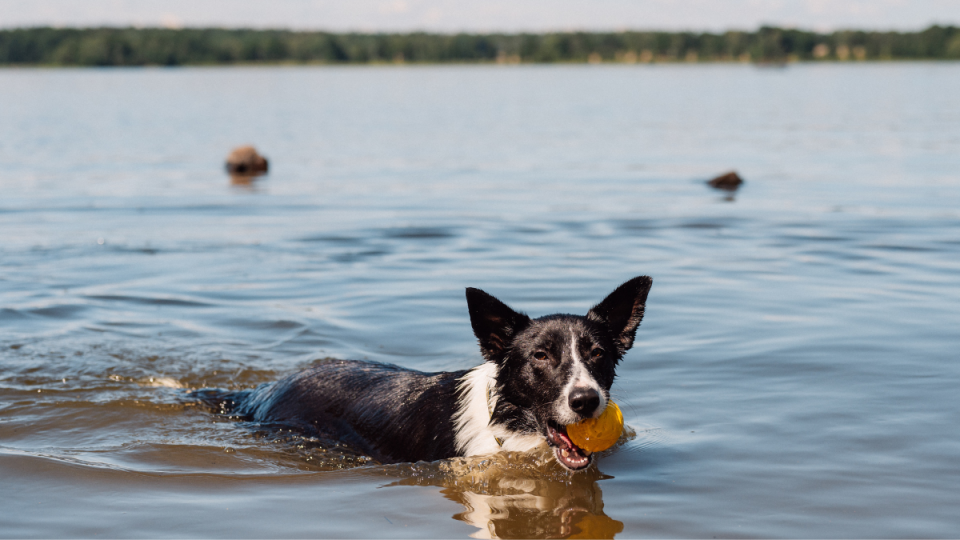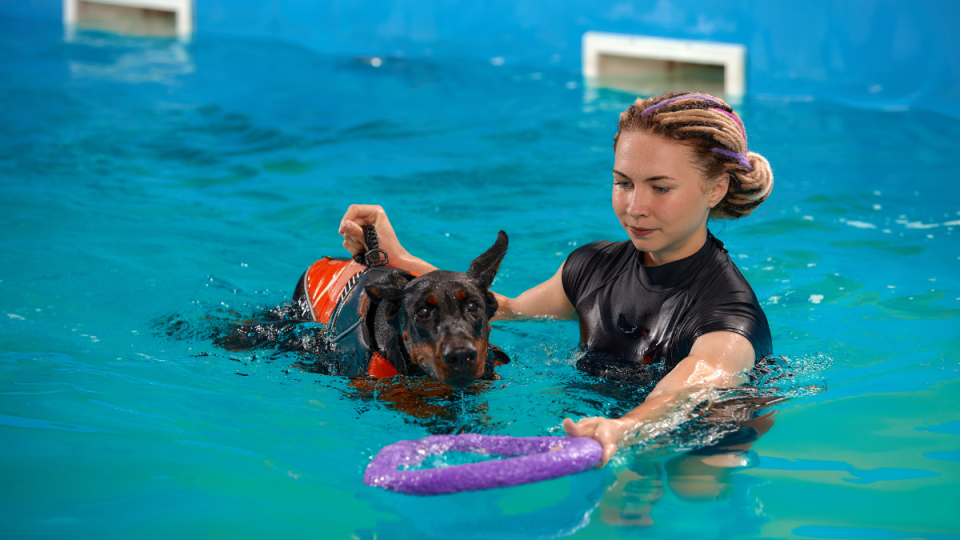Can All Dogs Swim? Discover the Answer + How to Keep All Dogs Safe in The Water
On days when the sun is shining and you’re ready to take a refreshing dip in a pool — or even head to the ocean or lake — it can be extra exciting to bring your dog along to join the fun! You and your canine companion may have a blast swimming together, but as with any swimmer (including humans), you can’t just assume that your dog is ready to jump in and swim on their own. To help keep dogs safe and happy while swimming this summer, we asked experts the important questions, including “Can all dogs swim?” Keep scrolling to find out.
Can all dogs swim? Some can, but not all
One misconception surrounding this topic is that any dog will be able to instinctively keep itself afloat in the water. Despite the phrase “doggy paddle,” not every dog is inherently able to swim on their own. Experts say that while many dogs can be taught how to swim over time (only if they don’t mind the water and are willing to practice and learn, of course), swimming will come more naturally for some more than others depending on multiple factors.
A dog’s breed determines their natural ability to swim
Ultimately, every dog is an individual with a unique temperament. A dog whose genetic makeup might imply that they’d be a great swimmer might simply have a personal aversion to water, and a dog whose breed is notably not a strong swimmer could have an affinity for bodies of water. That being said, certain physical characteristics associated with specific breeds make those dogs more inclined to thrive in and enjoy the water.
Related: Why Do Dogs Put Their Paw on You? Experts Explain What Your Pup Is Trying to Tell You
Dogs that are not made to swim
“There are dogs like Pugs, Boxers and Bulldogs that have flat faces, also known as brachycephalic, which will have a hard time keeping their faces above water and will give them issues with breathing on a whole,” says JustAnswer Dog Behavior Expert Sally Grottini.
Bulldog variations are also at a disadvantage when it comes to swimming due to their rotund body shape, weight distribution and small legs.
“Short legs (and a relatively large body) make forward propulsion through the water difficult, and a short muzzle means an increased chance of water entering the nose,” says Jenna Dockweiler, Veterinary Geneticist with Embark. “Additionally, the bulldog-type breeds tend to have large barrel chests, which skews their weight distribution toward the front of the body. These breeds sometimes have difficulty remaining afloat when in the water.”

Basset Hounds and Dachshunds, with their elongated mid-sections and disproportionately short legs, are also not born swimmers. Additionally, their long ears are prone to infection and irritation from being submerged in the water.
According to Nicole Ellis, a Certified Professional Dog Trainer and Pet Lifestyle Expert with Rover, dogs with dense, heavy coats that absorb water easily may find it harder to stay buoyant or maneuver easily due to the weight of the wet fur.
Dog breeds known as strong swimmers
Ellis explains that dogs with well-developed muscles — particularly in their hindquarters — tend to have greater power to push through the water.
“Some breeds, such as the Portuguese water dog, were designed for water; it’s right there in the name!” says Dockweiler. “Many of the retriever breeds were bred specifically to retrieve game from water for the hunter. Most dogs bred to work in water love to swim (though not always!”
Grottini also notes that breeds with like Newfoundlands have naturally webbed feet (no space between their toes) which act as paddles, making it easier for them to swim. Newfoundlands also have large lungs and strong bodies, so they can also sustain longer and farther swims.
These dogs have even historically been trained to help rescue people from bodies of water. See these heroes in action in this video!
The type of coat a dog has also plays a part in how they fare in the water. Grottini explains that breeds like the Chesapeake Retriever, for example, have oily waterproof coats that protect their skin and body, and the Otterhound benefits from both webbed feet and a rough double coat.
Related: One Woman Provides Service Dogs For Veterans: “They Help Save Lives!”
How to teach a dog to swim
Regardless of how their physical traits interact with water, you can teach a dog to swim if they are comfortable getting acclimated. Experts suggest a slow and steady process, and a lot of patience. You should be willing to invest in a quality floating device, stay near the dog in order to assist them and be in close proximity in case of emergency and always respect their boundaries without pushing or forcing them in any capacity.
“If you want to teach your dog to swim, you need to be in the water with them and holding their underbelly steady so they learn to paddle with their feet,” says Grottini. “Gradually you will let loose a little to see if they can handle it on their own, but never remove your arms from underneath them fully in case they cannot handle it.”

In order to gauge how your dog feels about water, be attentive to their demeanor, body language and behavior in general. Ellis says some signs that indicate a potential enjoyment of water include curiosity, excitement and a willingness to explore water sources like puddles or shallow streams.
To get your dog accustomed to water, Dockweiler suggests starting with a kid’s pool or the bathtub and a small amount of water. If your dog seems comfortable, you can gradually increase the depth of the water. Once the dog seems ready for a deeper body, she says, try to find somewhere with a gradual slope into the water (rather than a pool with an edge) and make sure the dog is aware of their exits.
Watch this TikTok from @chasin_chester of a Golden Retriever enjoying his swimming lesson!
If your dog tends to be social, it can be fun and helpful to bring them to or create an environment where other dogs are romping through the water as this might encourage them to join their canine companions. Think puppy pool party!
How to keep your dog safe while swimming
In addition to keeping an eye on and offering support to your dog in the water, it’s also your responsibility to be proactive in keeping them safe and healthy. Test the water temperature to ensure it’s not too cold for your pup, and keep your dog out of waters that might be unpredictable.
“You should also be watching for signs of exhaustion (excessive panting, trembling, weight shifting, etc.) and enforcing periods of rest if needed,” Dockweiler advises.

A properly fitted life jacket that allows mobility and visibility while also keeping your dog afloat is a must, even for seasoned swimmers, and experts suggest vests with a handle on top so you can always access your dog.
“Always use a life jacket. Dogs that are uncertain swimmers often only use their front legs to swim and a life jacket can greatly assist by the buoyancy it offers,” Ellis says. “It also enables better techniques which will help reduce the amount of water swallowed by dogs that aren’t the best swimmers or helps optimize leg movement.”
Expert tip: It’s never good for your dog to drink the water they’re swimming in, and chlorine and salt water can both pose potential health hazards to your dog. Be sure they’re not ingesting an excessive amount and keep fresh water readily available for them at all times.
Click through for more interesting facts about dogs!
Why Do Dogs Put Their Paw on You? Experts Explain What Your Pup Is Trying to Tell You
Can Dogs Eat Ginger? Vets on What You Need to Know + Red Flag Foods to Avoid
Can Dogs Understand Human Language? What the Science Says About “Dognition”

